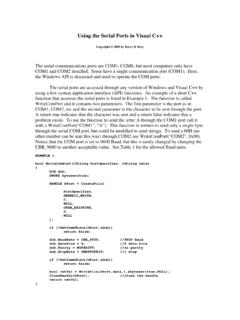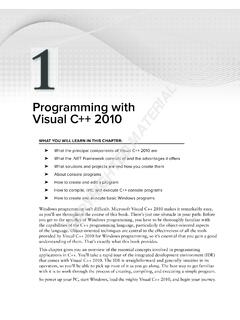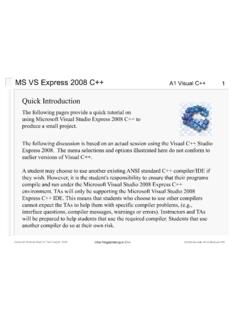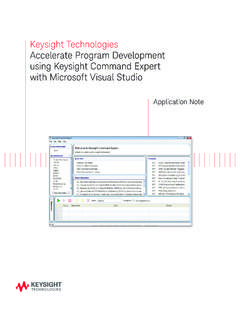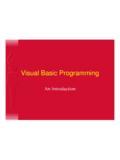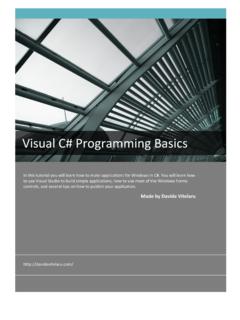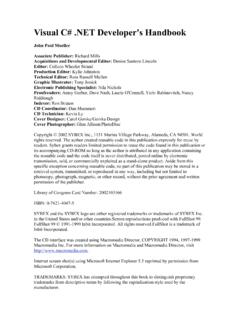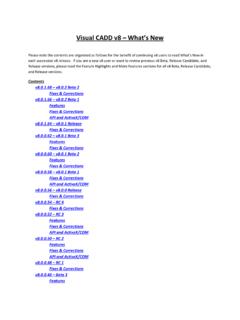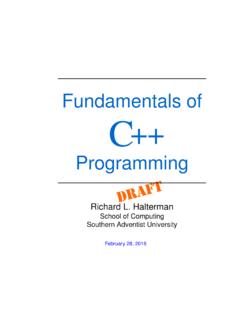Transcription of Visual C++ in 12 Easy Lessons - hbci.com
1 Visual C++ in 12 easy Lessons Visual C++ in 12 easy Lessons Acknowledgments About the Authors Introduction - 1 -Programming and Visual C++ - 2 -Overview of C++ Programs - Project 1 -Programming with Visual C++ - 3 -Style Issues - 4 - Visual C++'s Program Structure - Project 2 -Analyzing Visual C++ Programs - 5 -Numbers and Characters - 6 -String Data and I/O - Project 3 -Data Basics - 7 -Fundamental Math Operators - 8 -Relational and Logical Operators - Project 4 -Simple Operators - 9 -Special Operations - 10 -Power with switch - Project 5 -Taking Charge - 11 -What while Is for - 12 -Controlling Loops and Branching - Project 6 -Looping Back and Forth - 13 -Building Your Own Functions - 14 -More on Functions - Project 7 -Break It Up with Functions - 15 -Arrays Multiply Storage - 16 -Pointers Simplified - Project 8 -Lots of Data - 17 -Structure with struct - 18 -Allocating Memory - Project 9 -Consolidating Items - 19 -Object-Oriented Programming - 20 -Making and Breaking Classes - Project 10 -Object-Oriented Programming - 21 -Inheritance - 22 -Polymorphism: Calling the Right Function - Project 11 -Inheritance and Virtual Functions - 23 - Visual C++ Library of Functions - 24-Storing Data in Files - Project 12 -Using Disk Files - A -Installing Microsoft Visual C++ - B -The ASCII Table - C - Visual C++ Operator Precedence Table - D - Visual C++ Command Reference n Copyright 1995 by Sams Publishing n Who Should Use This Book n This Book's Philosophy n A Note to the Instructor n Overview n lesson 1: Programming with Visual C++ n lesson 2: Analyzing Visual C++ Programs n lesson 3: Data Basics n lesson 4: Simple Operators n lesson 5: Upgraded Operators n lesson 6: Looping Back and Forth n lesson 7: Break It Up with Functions n lesson 8: Lots of Data n lesson 9: Consolidating Items n lesson 10.
2 Object-Oriented Programming n lesson 11: Inheritance and Virtual Functions n lesson 12: Using Disk Filesn This Book's CD n Conventions Used in This BookVisual C++ in 12 easy LessonsGreg Perry and Ian Spencer 201 West 103rd Street, Indianapolis, Indiana 46290 For Mary. Copyright 1995 by Sams PublishingFIRST EDITION All rights reserved. No part of this book shall be reproduced, stored in a retrieval system, or transmitted by any means, electronic, mechanical, photocopying, recording, or otherwise, without written permission from the publisher. No patent liability is assumed with respect to the use of the information contained herein. Although every precaution has been taken in the preparation of this book, the publisher and author assume no responsibility for errors or omissions. Neither is any liability assumed for damages resulting from the use of the information contained herein. For information, address Sams Publishing, 201 W.
3 103rd St., Indianapolis, IN 46290. International Standard Book Number: 0-672-30637-9 Library of Congress Catalog Card Number: 95-688-46 98 - 97 - 96 - 95 ------ 4 - 3 - 2 - 1 Interpretation of the printing code: the rightmost double-digit number is the year of the book's printing; the rightmost single-digit, the number of the book's printing. For example, a printing code of 95-1 shows that the first printing of the book occurred in 1995. Printed in the United States of America All terms mentioned in this book that are known to be trademarks or service marks have been appropriately capitalized. Sams Publishing cannot attest to the accuracy of this information. Use of a term in this book should not be regarded as affecting the validity of any trademark or service mark. Visual C++ is a trademark of Microsoft Corporation. Publisher and President: Richard K. Swadley Acquisitions Manager: Greg Wiegand Development Manager: Dean Miller Managing Editor: Cindy Morrow Marketing Manager: Gregg Bushyeager Assistant Marketing Manager: Michelle Milner AcknowledgmentsI want to thank the editors at Sams Publishing, who somehow take my words and turn them into coherent readable text.
4 Rosemarie Graham and Dean Miller have been behind me for years, and I thank them sincerely. I especially want to thank Grace Buechlein for her support before and during this book. My hat goes off also to Ian Spencer for his superior expertise that made this book possible. About the AuthorsGreg Perry is quickly becoming one of the most sought-after speakers and writers in the programming field. He is known for being able to take programming topics and bring them down to the beginner's level. Perry has been a programmer and trainer for the past 18 years. He received his first degree in computer science, and then he received a master's degree in corporate finance. Perry is the author of more than 35 other computer books, including Teach Yourself Object-Oriented Programming with Visual C++, Moving from C to C++, QBasic Programming 101 (all from Sams Publishing), and The Complete Idiot's Guide to Visual Basic (from Alpha Books). In addition, he has published articles in several publications, including Software Development, Access Advisor, PC World, and Data Training.
5 In his spare time, he wanders around Italy, eating the world's best ice cream and pasta. Ian Spencer is a freelance consultant experienced in the diverse worlds of Windows application development and midrange systems development, especially with IBM systems. He has been in the computer industry since graduating in 1981 with a degree in Computer Science from Manchester University. His main business interests are in providing business solutions in the world of manufacturing companies and providing troubleshooting assistance on development projects. He has written a number of systems using C++ and class libraries, and he is well-respected as an authority on Windows programming. His other books include Teach Yourself OWL Programming in 21 Days (Sams Publishing). Ian lives in Walsall somewhere near the middle of England with his wife Mary, daughters Philippa and Suzanne, and their dog Ross. IntroductionThe book you hold offers something you might not have encountered before.
6 Whereas other books teach you Visual C++, this book also includes a Visual C++ compiler. With this book, there is literally nothing else to buy (except, of course, the computer)! Microsoft's Visual C++ compiler turns your computer into a C++ programming powerhouse. The compiler included is the full Visual C++ release including all the online help, source code, and libraries. The CD that comes with this book also includes all the code listings in the book, as well as answers to all the exercises at the end of each unit. Despite the great CD included, this book would be worthless if it didn't teach C++. Visual C++ in 12 easy Lessons starts at the beginning, assuming that you don't know Visual C++. By the time you're finished, you will have mastered the Visual C++ language. You'll be learning how to program, how to perform input and output, how to work with disk files, and how to achieve advanced memory management through Visual C++ programs. If you've looked at the computer want ads lately, you've surely noticed the assortment of C++ programming positions.
7 It seems as if there are always more jobs than C++ programmers. Why not join the ranks? This book will help get you there. Who Should Use This BookVisual C++ in 12 easy Lessons is aimed primarily at beginning programmers who have never programmed or have never seen a C++ program. Text, questions, exercises, and numerous program listings are aimed at both beginning programmers and those new to Visual C++. If you already program but have never had the time to tackle Visual C++, this book is right for you because it teaches more than just the language. This book attempts to teach you how to program correctly, concentrating on proper coding techniques in addition to the Visual C++ language. This book does not attempt to cover the difficult topic of Windows programming because we believe you need to know the basics of programming first. This Book's PhilosophyVisual C++ in 12 easy Lessons extends the traditional programming textbook tutorial by offering all the text and language syntax needed for newcomers to C++.
8 It also offers complete program examples, exercises, questions, tips, warnings, notes and, of course, a full-featured Visual C++ compiler. This book focuses on programming correctly in Visual C++ by teaching structured programming techniques and proper program design. Emphasis is placed on a program's readability rather than on "tricks of the trade" code examples. In this changing world, programs should be clear, properly structured, and well documented. This book doesn't waver from that philosophy. A Note to the InstructorIf you're an instructor using this book for your class, you'll find that the inclusion of a Visual C++ compiler lets the entire class participate on the same level, using the same compiler for their programs. When you demonstrate the editing, compiling, linking, and running of Visual C++ programs, you'll know that your students will be using the same compiler that you use in class. Each unit offers numerous questions and exercises that provide a foundation for classroom discussions.
9 The answers to all the questions and exercises are on the enclosed CD. In addition, each unit contains one or more Extra Credit programming exercises that you can assign as homework. The answers to these exercises don't appear on the CD. The typical semester class is divided into 15 or 16 weeks of study. A useful lesson plan that incorporates this book would spend one week on each lesson , with four exams (one every four weeks). Each lesson contains two units, and one unit can easily be covered in one classroom sitting. Because Visual C++ in 12 easy Lessons becomes a part-time teacher, questioning and guiding the student as he or she reads and learns, you can spend more classroom time looking at complete program examples and exploring the theory of Visual C++ instead of taking time to cover petty details. OverviewHere is an overview of this book, giving you a bird's-eye view of where you're about to head: lesson 1: Programming with Visual C++This lesson explains what Visual C++ is by giving a brief history of the C++ programming language and presenting an overview of C++'s advantages over other languages.
10 You'll learn how to develop Visual C++ programs and the steps you follow to write and run programs. You'll dive right into working with the Visual C++ compiler in the second unit. The focus is on using the Visual Workbench to easily compile and run programs. lesson 2: Analyzing Visual C++ ProgramsThis lesson familiarizes you with the format of Visual C++ programs. After you master this lesson , you'll be able to recognize Visual C++ programs and write simple programs that output data. lesson 3: Data BasicsVisual C++ supports all kinds of data. This lesson teaches you about Visual C++ variables. You must understand the various data types possible in Visual C++ before you can work with data. You'll see how Visual C++ supports both numeric and character data. lesson 4: Simple OperatorsThis lesson introduces you to the rich assortment of Visual C++ operators. These operators make up for the fact that the Visual C++ programming language is very small.

